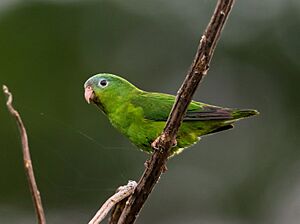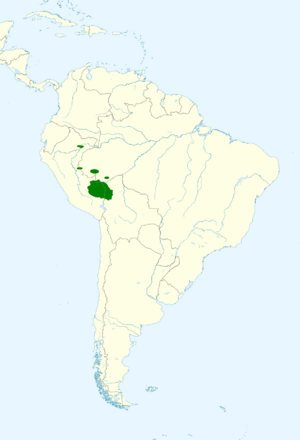Manu parrotlet facts for kids
Quick facts for kids Manu parrotlet |
|
|---|---|
 |
|
| Conservation status | |
| Scientific classification | |
| Genus: |
Nannopsittaca
|
| Species: |
dachilleae
|
 |
|
| Synonyms | |
|
Forpus dachilleae |
|
The Manu parrotlet (Nannopsittaca dachilleae), also called the Amazonian parrotlet, is a small parrot. It lives in the western Amazon basin, which includes parts of southern Peru and northwest Bolivia. You can find these birds in lowland forests, especially near bamboo plants and rivers.
The IUCN (International Union for Conservation of Nature) lists the Manu parrotlet as a species of Least Concern. This means it is not currently in danger of extinction.
Contents
Discovering the Manu Parrotlet
Scientists first found the Manu parrotlet in 1985. The team included John P. O’Neill, Charles A. Munn, and Irma Franke. They were exploring the Manú River area in Manú National Park in eastern Peru.
The new species was named after Barbara D’Achille. She was a conservationist and journalist who worked with the scientists. The name Nannopsittaca dachilleae means "dwarf parrot of d'Achille." Nanus is Latin for dwarf, and psittaca is Latin for parrot.
What Does the Manu Parrotlet Look Like?
The Manu parrotlet is mostly bright green. Its back, wings, and tail feathers are all this vibrant green color. The front of its head, near its forehead and crown, is a pale blue.
Its chest, belly, and the feathers under its tail are a lighter, yellowish-green. So far, scientists have not found any major differences in appearance between male and female Manu parrotlets.
Manu Parrotlet Behavior
Researchers have often seen Manu parrotlets flying in groups. These groups usually have between 5 and 12 birds. When they are together, the flocks make sounds that are like squawking or peeping.
Scientists once saw a possible nest. It was a burrow hidden among a group of bromeliads. Bromeliads are plants that often grow on trees.
What Do Manu Parrotlets Eat?
Manu parrotlets often look for food on the ground. They especially like to eat seeds from bamboo plants, particularly those from the Guadua genus.
They also get important nutrients from "clay licks." These are areas where a river has exposed a vertical bank of clay. The birds eat this clay to get sodium and other minerals. Manu parrotlets visit these clay licks every two or three days, usually around midday. They often join other parrot species, like the dusky-billed parrotlet and tui parakeet. The Manu parrotlets spend about 30 minutes eating the clay.
Where Do Manu Parrotlets Live?
The Manu parrotlet lives in different areas across Brazil, Bolivia, and Peru. Most of them are found in Peru. They prefer forests that grow along rivers, especially those with trees like Calocophyllum spruceanum and Cecropia membranacea.
Protecting the Manu Parrotlet
The biggest threats to the Manu parrotlet are habitat fragmentation and damage to their homes. This often happens because of industries like mining and the roads built for them. These activities can break up the forests where the parrotlets live.


